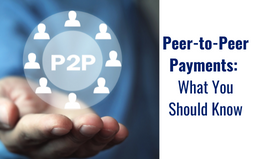Peer-to-Peer Payments

Peer-to-peer or P2P payments are gaining in popularity with all age demographics. P2P payments are an easy way to send money to another person without using cash. Simply connect your bank account or debit card to one of the many money transfer apps available and you’re ready to go. Money added to your app can be left there for later use or transferred directly to your bank account.
P2P payments especially come in handy for things like splitting a bill at dinner or paying for a school fundraiser. It’s a convenient option for those that don’t always have cash on hand.
There are many apps available for P2P payments. Some of the most popular P2P payment apps are:
Your financial institution usually has an option as well.
If you are a Pennian Bank Digital Baking user, you can send payments to an individual through Bill Pay. When adding a payee, simply select “Individual” and add the information. They don’t need a Pennian account, just a valid phone number or email address.
While the more popular apps boast convenience, they should be used with caution. Scammers have found a way to get your money through these apps. However, you can guard yourself against the bad guys with some extra precautions.
Peer-to-peer payment security tips:
- Only send and receive money from people you know.
- If you receive an unexpected request, check with the person to be sure they haven’t been hacked.
- Use a PIN number, multi-factor authentication or both to protect your account.
- Set up notifications to receive a message any time a transaction is made.
- Set up notifications to receive a message any time a transaction is made.
- Keep your credentials confidential.
Find out more about P2P scams and how to report them here.